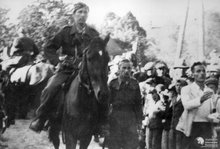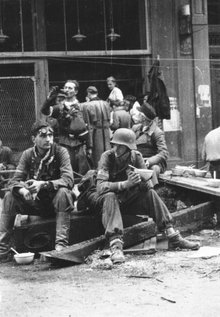Operation Tempest
|
|
7InfDivAK_Radom-Kielce.jpg
Template:Polish Secret State small Operation Tempest (Polish: Plan Burza, sometimes also translated as Operation Storm) was a series of planned local uprisings prepared by the Polish Home Army during World War II.
The main aim of the operation was to seize control of the cities and areas where the German forces were preparing their defence against the Red Army and allow the underground civil authorities to take them over before the arrival of the Soviets

| Contents |
History
Plan

The Home Army had been preparing an national armed uprising against the Germans ever since its creation. In September 1942 the basic framework of the future uprising was created. According to the plan, the Uprising was to be ordered by the Commander in Chief when the defeat of the Wehrmacht on the Eastern Front is apparent. The uprising was to be started in the Central Poland: General Gouvernement, Zagłębie, Kraków Voivodship, Białystok area and Brześć region.
The basic aims were as follows:
- Putting an end to German occupation
- Seizing arms and supplies for the recreation of regular army
- Countering the threat from the Ukrainian Uprising Army
- Reconstruction of regular Polish Army
- Reconstruction of civil authorities, communication and arms industry
- Maintaining peace and order behind the front lines
- Starting offensive movements against the Wehrmacht forces still on Polish land
The reconstruction of the regular army was to be based on pre-war Polish Order of Battle. The Home Army units were to be turned into regular divisions. Initially 16 Infantry Divisions, 3 cavalry brigades and 1 motorized brigade were to be created, either from captured equipment or from arms and supplies delivered by the Allies. The second phase of the reconstruction assumed the creation of additional 15 divisions and 5 cavalry brigades which, before the war, had been stationed in the eastern and western Poland.
The plan had been agreed and partly implemented. From 1943 the Home Army units were grouped in larger units bearing the names and numbers of pre-war Polish divisions, brigades and regiments.
Ponury_group_Wykus.jpg
Allies' Ally
In early 1943, after the German defeat at Stalingrad, it became clear that the Allied invasion in the West had not progressed sufficiently so the Uprising would have to be aimed at the still powerful German army, rather than against German units retreating rapidly to their already-beaten homeland.
In February 1943 General Stefan Rowecki amended the plan. The Uprising was to be started in three parts. The first part was an armed uprising in the East (with main centres of resistance in Lwów and Wilno), before the advancing Red Army. To prepare it the Wachlarz operation was started instantly. The second part was to be an armed struggle in the belt between the Curzon Line and the Vistula river, while the third part was to become a national uprising in the rest of Poland.
Polish-Soviet diplomatic relations were broken by Stalin on April 25, 1943 due to the Katyn massacre case and it became obvious that the advancing Red Army might not come to Poland as a liberator but rather, as General Rowecki put it, Our Allies' Ally. On November 26, 1943 the Polish government in exile issued an instruction, which assumed that if the diplomatic relations with Soviet Union were not resumed before their entry to Poland, the Home Army forces were to remain underground until further decisions were made.
However, the Home Army commander took a different approach and on November 30, 1943 the final version of the plan was created.
Operation Tempest
The main aims of the plan were to cooperate with the advancing Red Army forces on the tactical level while at the same time the civil authorities were to come out of underground and take over the power on Allied-controlled territories. The plan was accepted by the Delegate of the Polish government in exile and the Polish underground parliament (Krajowa Reprezentacja Polityczna).
On January 2, 1944 the Red Army forces of the 2nd Belarusian Front entered the pre-war borders of Poland. At the same time the massacres of Poles in Volhynia reached their peak and the 27th Polish Home Army Infantry Division was recreated. Thus the Operation Tempest was started. The effects of Divisions' fights were promising as it managed to get in touch with the commanders of the advancing Red Army and started a successful cooperation against the Wehrmacht. Together with the Soviets it liberated Kowel (April 6) and Włodzimierz. However, soon the division was forced to retreat westwards and in Polesie region it was being attacked by both German and Soviet forces. Captured Polish soldiers were taken POW and given the choice of either joining the Red Army or being sent to Gulag. The remnants of the division crossed the Bug river, where they were attacked by the Soviet partisan units. After liberating the towns of Lubartów and Kock, the division (reduced to approx. 3,200 men) was surrounded by the Red Army and taken prisoner.
Operation Ostra Brama
for more information see: Wilno Uprising
In the north the forces of Wilno and Nowogródek Home Army districts (approximately 13.000 soldiers under col. Aleksander Krzyżanowski) started an armed uprising in Wilno (now Vilnius) on June 7, 1944, successfully liberating the city before the Red Army forces reached it. By June 14 both the city and its surroundings were liberated by Polish 19th Home Army Infantry Division. However, both the Polish forces and the civil authorities were captured by the Soviets and sent to Russia.
Lwów Uprising
for more information see: Lwow Uprising
Lwow_Uprising_AK.jpg
On July 23 the Home Army forces in Lwów (now Lviv) started an armed uprising as well, in cooperation with the advancing Soviet forces. The city was liberated in four days. After that the civil and military authorities were summoned for a meeting with Red Army commanders and captured by the NKVD. The remaining forces of col. Władysław Filipkowski were either forcibly conscripted to the Red Army, sent to Gulag or returned to the underground.
Warsaw Uprising
for more information see: Warsaw Uprising
Seeing the fate of all the Home Army forces taking part in the Operation Tempest, both the Polish government in exile and gen. Tadeusz "Bór" Komorowski decided, that the last chance for regaining independence was to start an uprising in Warsaw. On July 21 1944 the latter ordered the Warsaw Uprising to be started at 17:00, August 1, 1944. The political aim was to underline the existence of both Polish civil authorities and the government to the Allies. The city was to be taken in order to allow the legitimate government return.
At the same time other Home Army districts were also mobilized. In the Kielce and Radom area the 2nd Polish Home Army Division was formed and practically took control of all the area except for the cities themselves. Other units were also re-created in Kraków, Łódź and Grand Poland.
Effects
The failure of the Warsaw Uprising marked the end of the Operation Tempest. Despite local successes, Stalin did not want to let the Polish government return and instead created a puppet Moscow-backed government while arresting or killing the Home Army and the members of the civil authorities. In the autumn of 1944 many Home Army units were disbanded, while the remaining forces returned underground.
